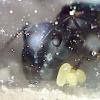Well, now I have some questions!
How worried should I be about test tubes flooding while they are in hibernation?
Do they eat anything- even just a little sugar water during hibernation?
What are the chances of test tube flooding during hibernation?
Are there any ways to reduce flooding of test tubes while they are in hibernation? (For example, keeping the front of the tube lifted slightly)
Are there just any major things I need to look out for?
I have never seen flooding while in hibernation, just when the test tube warms up causing the water to expand.
Some species go completely motionless, and even fall over and look dead.
Other species, such as Lasius, are known for being semi-active during hibernation. Those that are a bit active I will offer one small drop of sugar water/hummingbird nectar about once a month. Nothing other than sugar though, as cooler temperatures they will have a harder digesting it.
To reduce chance of flooding, lift the open end of the test tube. Simply check on them every 3-4 days. Even if they are completely underwater, with the cooler temperatures they all seem to survive if you dump them onto paper towel. I had one Camponotus colony in a formicarium, and due to condensation the bottom of the plug in cooler filled with water without me noticing. They were competely submerged for at least 2 days, but I quickly dumped them them and the water out, and out of over 100 ants, I only lost one.
Hibernation is pretty care-free. I use a wine cooler with a glass door so I can keep an eye on them.


















